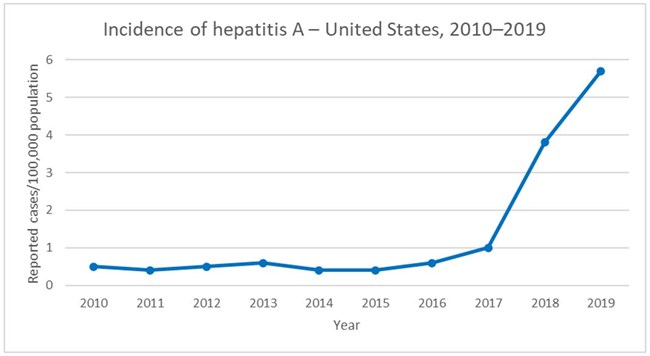Last updated: July 3, 2023
Article
Hepatitis A
(This page is part of a series. For information on other illnesses that can affect NPS employees, volunteers, commercial use providers, and visitors, please see the NPS A–Z Health Topics index.)

CDC
Humans: Hepatitis A is a virus that causes a liver infection. The virus is found in the stool (poop) of people who are infected and can survive on surfaces for several months. Infection can occur when someone ingests the virus, usually through close personal contact with an infected person or through eating/drinking contaminated food or water. Hepatitis A is very contagious, and people can spread the virus up to two weeks before they get symptoms. One infected person working as a food handler while contagious can spread hepatitis A to dozens or even hundreds of other people. Symptoms include nausea, stomach pain, vomiting, diarrhea, loss of appetite, fatigue, dark-colored urine, and yellow skin or eyes. Many children and some adults have no symptoms, but others can develop severe disease. Those who do get sick may feel ill for a few weeks to several months. There is a highly effective vaccine for hepatitis A.
Animals: No animals are natural hosts of hepatitis A; however, several kinds of non-human primates have been infected in captivity.
Environment: Hepatitis A can survive outside of the human body for months. Heating foods and liquids to high temperatures of at least 185°F can kill the virus. However, hepatitis A virus is resistant to cold temperatures, and freezing will not kill it. Hepatitis A virus on environmental surfaces can be killed by disinfection with bleach, quaternary ammonium, or hydrochloric acid.
PREVENTION:
- Wash your hands thoroughly with soap and warm water after using the toilet, changing a diaper, or before eating or preparing food.
- Use water from a treated source (e.g., tap water) or water adequately treated in the backcountry by boiling for at least 1 minute OR filtering and chemically disinfecting (filtration alone is not effective for removing viruses) to wash produce.
- Get vaccinated if you are at increased risk for getting infected or for developing serious complications. These people include people who use drugs (including drugs that are not injected), people experiencing unstable housing or homelessness, men who have sex with men, people with chronic liver disease, and people who are or were recently in jail or prison. Two doses are needed for long term protection, but a single dose of vaccine can prevent you from getting infected during an outbreak.
- For employees:
- Follow guidance in the FDA Food Code, including minimize handling of foods that are ready to eat and never using your bare hands when handling food that won’t be cooked before it is eaten.
- Assess the need for the hepatitis A vaccine through a Job Hazard Analysis. Many employees ask if they should get the pre-exposure hepatitis A vaccine (HAV) because of occupational risk. Although hepatitis A vaccine is now part of the childhood immunization schedule, and many adults are recommended to get it based on other risk factors, the hepatitis A vaccine is not routinely or specifically recommended based on occupational risk for the majority of occupations, including healthcare personnel, persons handling untreated sewage, or food service establishments and food handlers. However, the need for HAV should be assessed in a Job Hazard Analysis with consideration given in situations in which an employee has significant exposure to untreated human waste, there are local outbreaks of hepatitis A, or there is high visitation from areas in which hepatitis A is endemic.
- Promptly report any case of hepatitis A occurring in NPS employees, concessioners, or visitors as directed in the Disease Reporting section below. In some situations, post-exposure prophylaxis may be recommended to unvaccinated persons at risk.
- Employers:
- Ensure adherence to the FDA Food Code, including exclusion of food service employees with hepatitis A or vomiting, diarrhea, or jaundice.
- Encourage and provide supplies for handwashing among all employees.
- Enhance cleaning and disinfecting routine of walls, floors, and food contact equipment, including cutting boards, utensils, dishes, and pans. Use a chlorine bleach solution of 1 tablespoon of chlorine bleach to 1 gallon of hot water, or other approved sanitizers.
(Last updated: July 3, 2023)

